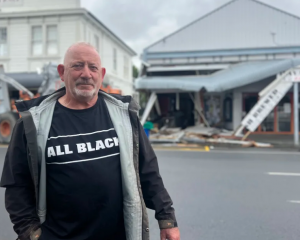He's older and the boat's a lot bigger than the dinghy he first messed about in as a child in Port Chalmers but Peter Scott is still excited by the prospect of fishing.
Mr Scott recently launched Fierce Elegance Charters from Careys Bay, the perfect fit to his other more adrenaline-filled venture - shark cage diving off the coast of Stewart Island - as it worked in the off-season.
A colourful character, Mr Scott is a genial host with many tales to tell from working in New Zealand's southern waters for more than 30 years.
Brought up in Port Chalmers, he did not come from a fishing background but his initiation into boats came at a young age.
"At the age of about eight or 10, everybody had a boat. It amazes me today, you drive around and see no young kids in boats.
"It guess things have changed, it's the computer age ... but we learned a lot of skills when we were that small, paddling around in boats,'' he said.
And boating, back then, was done without life-jackets, although they did have an alternative use - for padding otherwise uncomfortable seats.
"A few of us were probably lucky to survive,'' he reflected.
As a teenager in his school holidays, Mr Scott worked for local commercial fisherman Ate Heineman and it was a steep learning curve.
After leaving school, he continued to work for Mr Heineman as a deckhand before buying his own boat in his early 20s.
It was the early 1980s and interest rates were high. When he told his grandfather, a man who used to save every penny, that he had borrowed $100,000 at 22% the old man "just about had a heart attack''.
But the move paid off.
"I'm still here, I haven't gone bankrupt yet.''
That boat was later sold and he went back to work for Mr Heineman for a couple of weeks that turned into five or six years.
Other boats were later bought, including the 16m aluminium catamaran Fierce Elegance in September last year.
Able to carry up to 30 passengers, it included a full galley, bathroom and seating.
It was quicker and more stable than its predecessors.
A trip from Bluff to Otago Harbour took seven hours, instead of 18.
Shark cage diving remained the "bread and butter'' of Mr Scott's business and Shark Dive New Zealand was now in its ninth season.
The venture, which was only ever supposed to be a hobby, has now catered for thousands of adventure-loving visitors.
Mr Scott looked at "every shark cage in the world'' - and discovered there were some "pretty cheap ones'' - before coming up with the design of the one that he now used.
The idea was fairly simple - "drop it into the water and look at sharks'' - although he said there was a steep learning curve.
Why was he keen to have a closer encounter with a great white shark?
"Why do people wake up one morning and want to climb Mt Everest? Some hare-brained scheme pops into your head ... not that I'll ever be climbing Mt Everest,'' he said.
So what was it like the first time he stepped into the cage?
"Interesting would be the word. You go into something knowing absolutely nothing. You've got to work things out as you go. I guess we're still learning today. If you stop learning, you're going to run into problems,'' he said.
He started getting involved in a few documentaries, word spread and it "snowballed from there''.
Tours run from December to June, departing from Bluff.
It was now booked well in advance, attracting about an even mix of international and domestic tourists.
Of those tourists, he estimated about 95% probably came to specifically go shark diving.
The venture had attracted some opposition, mainly from Stewart Island, from some "with a bee in their bonnet'', but he was legally entitled to run the business, he said.
Moving from his old boat to the catamaran opened up other opportunities, such as the charter operation.
Running from June through December, it was available for fishing trips, harbour cruising and corporate events.
It also kept the boat moving during the off-season and he still reckoned some of the best days' fishing were during winter.
He had been surprised by the response, thinking his customers would be solely local but he had already picked up a few who were travelling through the country and fancied a day's fishing.
Mr Scott believed fishing on the coast, out from Otago Harbour, was "pretty much under-rated'' and there were a lot of good places to go.
An advocate for sustainable fishing and not pillaging the waters, he questioned how agreement would be reached on marine protection areas.
The South East Marine Protection forum was set up in 2014 to consider marine protection options for the southern coastline, from Timaru to Waipapa Point at the southern end of the Catlins.
While he agreed there did need to be some protection, whether agreement of all parties involved could be reached was "anyone's guess''.
"The other issue with it ... they've got it too big to start with and there's too many options in that huge area for everyone to make a decision on,'' he said.
Mr Scott still did some relief commercial fishing when needed.












